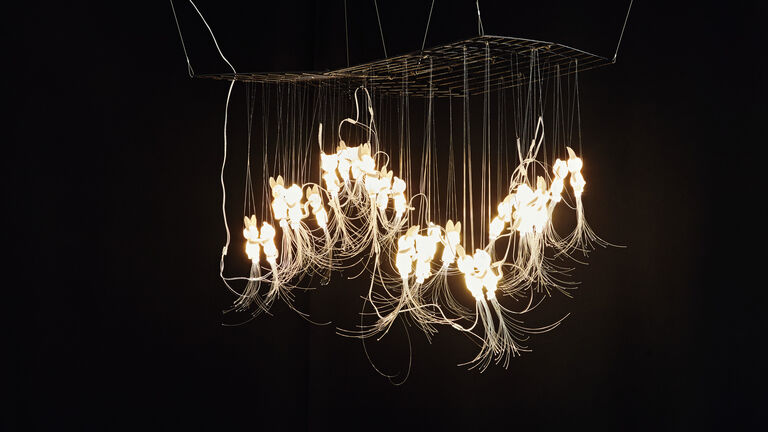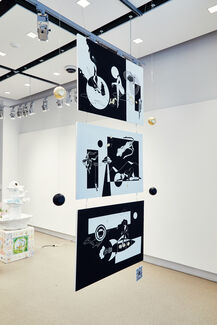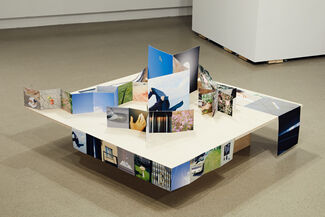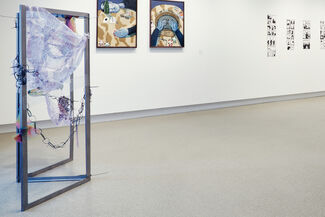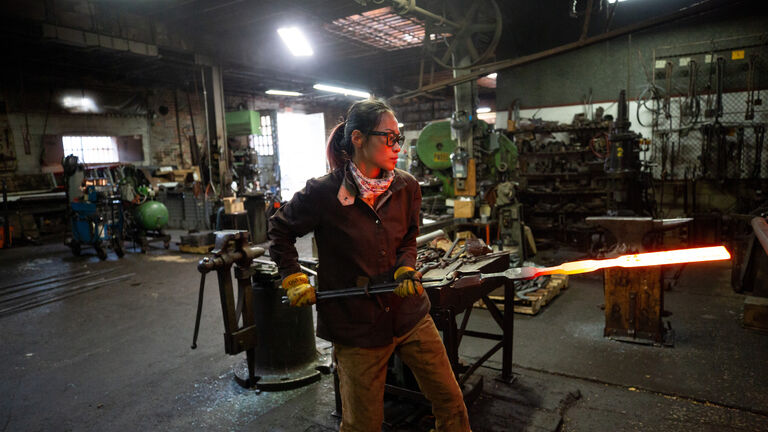
Photo by Grace DuVal
Interdisciplinary Freedom
Why You’ll Have No Major
A hybrid practice that crosses traditional disciplines is the foundation of some of the most dynamic contemporary creative work—and it’s at the heart of SAIC’s approach to educating emerging artists and designers. Our program is built for you to experiment across boundaries, immerse yourself in the ideas that interest you and intersect in your work, and develop a practice that is entirely your own.
Try Everything
When you’re free to experiment with the media that best express your ideas, you make new discoveries about how you can use materials, as well as in your thinking. You might collaborate with other students across disciplines. If you entered SAIC as, say, a painter, you might discover you’re actually a sculptor, or someone who sculpts with paint. The possibilities are limitless.
- Explore robotics and sound to invent a new instrument.
- Combine sculpture, ceramics, and fiber arts to create new installations.
- Merge your interests in drawing and printmaking to create graphic novels.
- Collaborate with a writer to make an animated film.
How It Works
You’ll have more than 1,000 courses to choose from each semester, so you can construct your own experience across disciplines. Your dedicated advisor will help you find your way as you explore possibilities, spending time with you and your work, and guiding you toward the courses and opportunities that will expand your practice.
A Grounding in Contemporary Practices
During your first year at SAIC you’ll test the ideas that drive contemporary art practices. This foundational course will expose you to diverse modes of making and a dynamic range of methodologies, along with conceptual thinking and artistic research.
Undergraduate Degree Programs
-
The Bachelor of Arts in Art History draws on the depth and diversity of offerings in the scholarly study of art practices that only a major art school connected with a world-class museum can offer. The international networks for contemporary art are an important part of the course offerings, and we offer a wide range of classes in Asian, African, Latin American, European, and North American Art. Substantial coursework in Art History, supported by additional coursework in Liberal Arts and in studio departments define the course of study.
Studio 18 - CP 1010 Core Studio Practice I (3)
- CP 1011 Core Studio Practice II (3)
- CP 1020 Research Studio I (3)
- CP 1022 Research Studio II (3)
- Studio electives (6)
Art History, Theory, and Criticism 51 - Foundations
- ARTHI 1001 World Cultures and Civilizations: Pre-History to 19th Century Art and Architecture (3)
- Additional Art History course at 1000-level (e.g., ARTHI 1002) (3)
- Research, Theory, and Methods
- SOPHSEM 2900 Sophomore Seminar in Art History (3)
- ARTHI 3900 Junior Proseminar Top Art History Methods * (3)
- ARTHI 4899 Senior Thesis I (3)
- ARTHI 4900 Senior Thesis II (3)
- Completion of written thesis
- Area Pathways *
Two complete 9 credit hour (3 courses) sequences from three possible areas of focus:
1. Asia
2. Europe and America
3. Southern Continents (Africa and Latin America)- Area Pathway I
ARTHI 2000-level survey (3)
ARTHI 3000-level intermediate course (3)
ARTHI 4000-level advanced course (3) - Pathway II
ARTHI 2000-level survey (3)
ARTHI 3000-level intermediate course (3)
ARTHI 4000-level advanced course (3)
- Area Pathway I
- Additional courses
- Art History courses in pre-modern topics, ARTHI 2000-4000 level* (6)
- Intermediate or Advanced Courses, ARTHI 3000-4000 level (9)
* A list of courses that fulfill this requirement is supplied by the Department. Each semester, the Department offers two smaller seminar-style courses focused on the application of research methods. These can be in any topic, but professors focus on the practice of research and writing with students in this smaller setting.
BA in Art History students must take at least one of these courses in their Junior year, which will be designated on the course schedule as ARTHI 3900/PROFPRAC 3900. Courses fulfilling the Junior Proseminar requirement cannot also be used to fulfill the Area Pathways requirements. Students may, however, take more than one Junior Proseminar in their time at SAIC, and any additional proseminars may be used to fulfill other degree requirements.
Liberal Arts 39 - ENGLISH 1001 First Year Seminar I (3)
- ENGLISH 1005 First Year Seminar II (3)
- Humanities (6)
- World History (6)
- Social Science (6)
- Natural Science (6)
- Foreign Language (6)
- Liberal Arts Electives (3)
General Electives 12 - Advanced elective courses (2000–4000 level), any department
In addition to courses in studio, Liberal Arts, of Art History, other opportunities such as internships taken through SAIC's Cooperative Education may count as electives.
Other Requirements
- BA in Art History students must complete at least 3 credit hours in a class designated as “off-campus study.” These credits can also fulfill any of the requirements listed above and be from any of the divisions (Art History, studio, Liberal Arts, or general electives).
Total Credit Hours 120 -
The Bachelor of Arts in Visual and Critical Studies degree program at SAIC allows you to pursue in-depth academic study in the creative environment of an art school. During your work, you will draw connections between the visual arts and history, philosophy, psychology, and the natural sciences.
Core Curriculum 36 - VCS 2001 Issues in Visual and Critical Studies (3)
- SOPHSEM 2900 (recommended to take VCS SOPHSEM in fall) (3)
- VCS 3001, 4010, and 5000 Topics in Visual and Critical Studies OR VCS 4050 VCS Studio Seminar (including 6 credits global / comparative) (18)
- PROFPRAC 3900 VCS Junior Seminar: Criticality in the Real World (take in fall of junior year) (3)
- VCS 3010 Tutorial in Visual and Critical Studies (3)
- VCS 4800 Undergraduate Thesis Seminar I: Research and Writing (3)
- VCS 4900 VCS Undergraduate Thesis Seminar II: Research and Writing (3)
Studio 39 - CP 1010 Core Studio Practice I (3)
- CP 1011 Core Studio Practice II (3)
- CP 1020 Research Studio I (3)
- CP 1022 Research Studio II (3)
- Studio Electives (27)
Liberal Arts 24 - ENGLISH 1001 First Year Seminar I (3)
- ENGLISH 1005 First Year Seminar II (3)
- Humanities (6)
- Social Science (6)
- Natural Science (6)
Art History 9 - ARTHI 1001 World Cultures/Civilizations: Pre-History to 19th-Century Art and Architecture (3)
- Additional Art History course at 1000-level (e.g., ARTHI 1002) (3)
- Art History Elective at 2000 to 4000 level (3)
General Electives 12 Total Credit Hours 120 -
The Bachelor of Fine Arts in Art Education program educates students to become teachers of art, design, and visual culture while continuing to strengthen their own artmaking practices. SAIC's Art Education community supports students in becoming engaged and reflective teacher artists whose pedagogical work fosters the emergence of more just and joyous individuals and societies.
STUDIO
60 Credit Hours
- CP 1010 Core Studio Practice I (3)
- CP 1011 Core Studio Practice II (3)
- CP 1020 Research Studio I (3)
- CP 1022 Research Studio II (3)
- SOPHSEM 2900 (any section) (3)
- Drawing (6)
- Painting (3)
- Print Media (3)
- Ceramics OR Sculpture (3)
- ARTED 3900 Practices of Art and Design Education in Schools and Community: Teens and Adults (Professional Practice-SPINE) (3)
- ARTED 4100 Cultural Approaches to Production (3)
- Studio Electives* (24)
*Studio courses must include a minimum of 12 credits of 3000 or 4000 level courses.
ART HISTORY
12
- ARTHI 1001 World Cultures and Civilizations: Pre-History to 19th Century Art and Architecture (3)
- ARTHI 1002 Survey of Modern to Contemporary Art and Architecture (3)
- Global / Comparative Art History or Visual and Critical Studies (VCS) Course Elective (3)
- Art History or VCS Course: Additional Elective (3)
LIBERAL ARTS
30
- ENGLISH 1001 First Year Seminar I (3)
- ENGLISH 1005 First Year Seminar II (3)
- Natural Science (3)
- Math (or another Natural Science) (3)
- Social Science (6)
- Humanities (6)
- ARTED 3125 Doing Democracy (3)
- ARTED 3021 Becoming Human: Evolving Conceptions of Human Development (3)
ART EDUCATION
18
- ARTED 3015 Practices of Art & Design Education in Schools and Communities 1: Children & Youth (3)
- ARTED 4390 Practicum: Elementary and Secondary Experiences (3)
- ARTED 4900 Apprentice Teaching (Capstone) (12)
TOTAL CREDIT HOURS
120
-
The Bachelor of Fine Arts in Writing degree at SAIC emphasizes a process-based approach to creative writing—one in which students experience writing across genre and in interdisciplinary and hybrid modes. Fully integrated into SAIC’s studio departments, you will explore the relationship between language and visual art by connecting writing to comics, graphic novels, artist’s books, painting, performance, film, sound, and gallery installations.
Writing Core Curriculum 24 - HUM 2001 Literature Survey I (3)
- HUM 3002 Literature Survey II (3)
- WRIT 1101 Introduction to Writing as Art (3)
- WRIT 2040 Writing Workshop (3)
- WRIT 3140 Advanced Writing Workshop (3)
- WRIT 4001 Generative Seminar (6)
- WRIT 4900 BFAW Thesis Workshop (3)
Studio 36 - CP 1010 Core Studio Practice I (3)
- CP 1011 Core Studio Practice II (3)
- CP 1020 Research Studio I (3)
- CP 1022 Research Studio II (3)
- SOPHSEM 2900 (3)
- PROFPRAC 3900 (3)
- Studio Electives—May include additional Writing courses (18)
Liberal Arts 36 - ENGLISH 1001 First Year Seminar I (3)
- ENGLISH 1005 First Year Seminar II (3)
- Humanities (9)
- Social Sciences (9)
- Natural Sciences (6)
- Liberal Arts Electives (6)
Art History 12 - ARTHI 1001 World Cultures/Civilizations: Pre-History to 19th Century Art and Architecture (3)
- Additional Art History course at 1000-level (e.g., ARTHI 1002) (3)
- Art History Electives at the 2000 to 4000 level (6)
General Electives—Studio, Liberal Arts, Art History, and/or BFAW courses 12 Total Credit Hours 120 -
The Bachelor of Fine Arts (BFA) degree provides you a broad education that balances thinking and making, academic rigor, and experimental play. The BFA curriculum integrates academic and studio education—the classroom and the studio inform and enhance each other.
Studio 69 - CP 1010 Core Studio Practice I (3)
- CP 1011 Core Studio Practice II (3)
- CP 1020 Research Studio I (3)
- CP 1022 Research Studio II (3)
- SOPHSEM 2900 (3)
- PROFPRAC 39XX (3)
- CAPSTONE 49XX (3)
- Studio Electives (48)
Art History 15 - ARTHI 1001 World Cultures/Civilizations: Pre-History—19th Century Art and Architecture (3)
- Additional Art History Course at 1000-level (e.g., ARTHI 1002) (3)
- Art History Electives at 2000-, 3000-, or 4000-level (9)
Liberal Arts 30 - ENGLISH 1001 First Year Seminar I (3)
- ENGLISH 1005 First Year Seminar II (3)
- Natural Science (6)
- Social Science (6)
- Humanities (6)
- Liberal Arts Electives (6)
- Any of the above Liberal Arts or certain AAP or EIS
General Electives 6 - Studio, Art History, Liberal Arts, AAP, or EIS
Total Credit Hours 120 * BFA students must complete at least two classes designated as "off campus study." These classes can also fulfill any of the requirements listed above and be from any of the divisions (Art History, Studio, Liberal Arts, or General Electives).
BFA in Studio with Thesis Option (Liberal Arts or Visual Critical Studies): Students interested in pursuing the BFA in Studio with the Thesis Option (Liberal Arts or Visual Critical Studies) should contact their academic advisor for details about eligibility, program requirements, and the application process.
Total credits required for minimum residency 66 Minimum Studio Credit 42
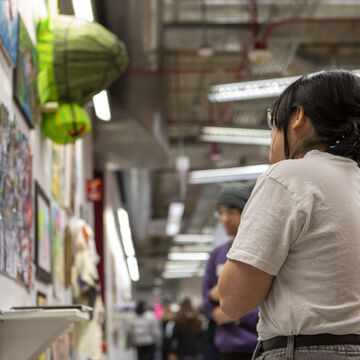
ArtBash
SAIC celebrates the work that first-year students have created with a major year-end art show of works in all media. ArtBash kicks off with an opening reception featuring Inter-Action—a showcase of live performance and ephemeral works.

Cildo Meireles, Insertions into Ideological Circuits: Coca-Cola Project, 1970
Resources to Explore
SAIC associate professor, adj. Magdalena Moskalewicz brings students into the Art Institute of Chicago museum to investigate a work by Brazilian artist Cildo Meireles. It’s an intervention, or an idea introduced into the world, that can’t be defined by medium.
Recent Undergraduate Work
Take in a student show at SAIC, and you’ll see a lot of work created outside the boundaries of any specific medium—work that melds making and meaning in unique ways.
